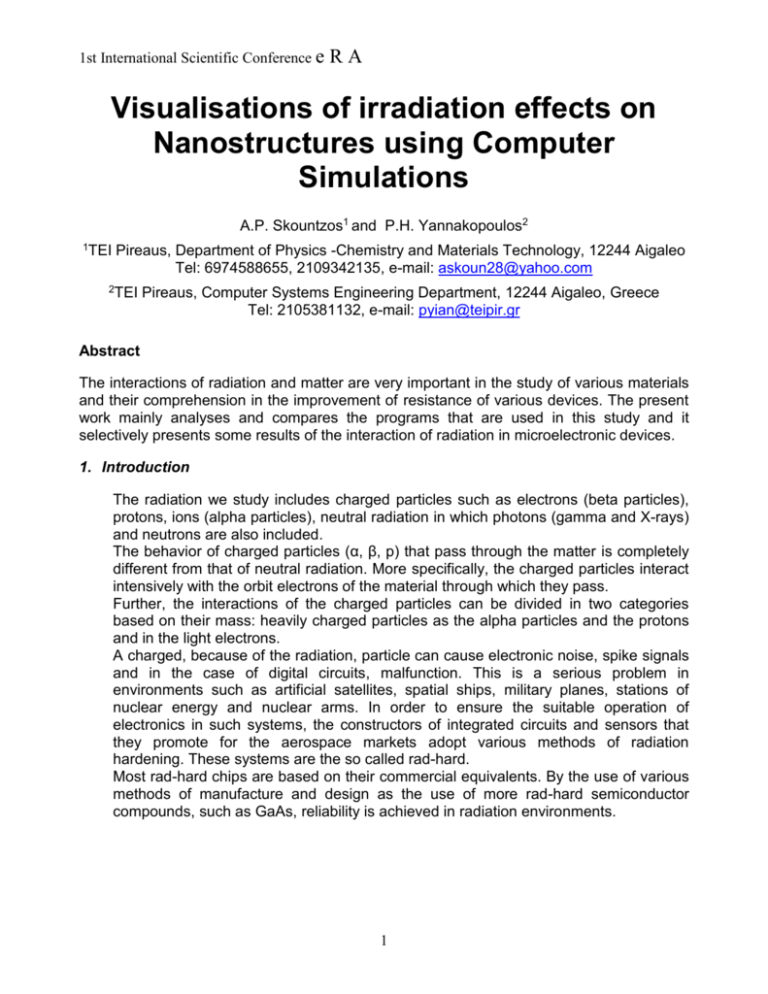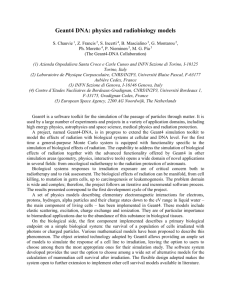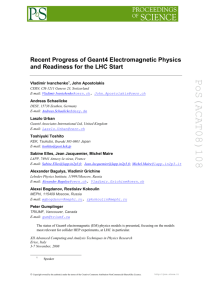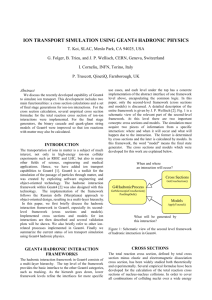Β.5.4. A. P. Skountzos and P. H. Yannakopoulos
advertisement

1st International Scientific Conference e RA Visualisations of irradiation effects on Nanostructures using Computer Simulations A.P. Skountzos1 and P.H. Yannakopoulos2 1TEI Pireaus, Department of Physics -Chemistry and Materials Technology, 12244 Aigaleo Tel: 6974588655, 2109342135, e-mail: askoun28@yahoo.com 2TEI Pireaus, Computer Systems Engineering Department, 12244 Aigaleo, Greece Tel: 2105381132, e-mail: pyian@teipir.gr Abstract The interactions of radiation and matter are very important in the study of various materials and their comprehension in the improvement of resistance of various devices. The present work mainly analyses and compares the programs that are used in this study and it selectively presents some results of the interaction of radiation in microelectronic devices. 1. Introduction The radiation we study includes charged particles such as electrons (beta particles), protons, ions (alpha particles), neutral radiation in which photons (gamma and X-rays) and neutrons are also included. The behavior of charged particles (α, β, p) that pass through the matter is completely different from that of neutral radiation. More specifically, the charged particles interact intensively with the orbit electrons of the material through which they pass. Further, the interactions of the charged particles can be divided in two categories based on their mass: heavily charged particles as the alpha particles and the protons and in the light electrons. A charged, because of the radiation, particle can cause electronic noise, spike signals and in the case of digital circuits, malfunction. This is a serious problem in environments such as artificial satellites, spatial ships, military planes, stations of nuclear energy and nuclear arms. In order to ensure the suitable operation of electronics in such systems, the constructors of integrated circuits and sensors that they promote for the aerospace markets adopt various methods of radiation hardening. These systems are the so called rad-hard. Most rad-hard chips are based on their commercial equivalents. By the use of various methods of manufacture and design as the use of more rad-hard semiconductor compounds, such as GaAs, reliability is achieved in radiation environments. 1 1st International Scientific Conference e RA 2. Software packages SRIM - 2003.026 (Stopping and Range of Ions in Matter) is a collection of programs that calculates the range of ions in matter (10eV - 2GeV/amu) using collisions of ions atoms with the aid of quantum mechanics. TRIM (Transport of Ions in Matter) accepts up to 8 complex targets from various materials. It calculates the 3D spread of ions as well as the all kinetic phenomena that are related with the loss of their energy: damage of the target, sputtering*, ionization and phonons production. The programs are constructed in such a way, so as to they can be interrupted any moment and restart later (Figure 1). The graphic representations can be saved and used later. SRIM-TRIM programs can handle ions. CASINO v.2.42 (Monte Carlo Simulation of electron trajectories in Solids) is a program of simulation with Monte Carlo with which we can see the trajectories of electrons in the matter as well as their results. (Figure 2). GEANT4 is the more powerful program that can handle all kinds of radiation, even non particles radiation. It consists of libraries of C++ programs that are used for simulations. GEANT4 has an interdisciplinary nature, that provides multi-functionalism in different scientific sectors. Simultaneously, the software of GEANT4 is configurable and it allows the user to upload and use only the components that he needs. The physical processes of GEANT4 exploit the object oriented technology that makes obvious the procedure by which the physical results are produced. Fig. 1: Typical TRIM Screen in which we specify the elements of a layer 2 1st International Scientific Conference e RA Fig. 2: Typical Casino 2.42 screens with the layer and its’ contents as well as the physical models SRIM-TRIM and Casino have graphical user interfaces which include all their functions and uses fully analysed. The experienced researcher would find those selfexplanatory and easy to use in order to produce accurate results. On the contrary Geant4, as already stated, is a collection of C++ libraries and the creation of a simulation consists of various classes in C++ that defines and describes the virtual experimental setup. This is a difficult process and requires extensive programming experience. There are some GUI available that somehow facilitate the process like MOMO (Figure 3). It includes GGE (Geant 4 Geometry Editor) GPE (Geant4 Physics Editor) GAG with a graphical way and you can create your own file and it runs under JAVA. 3 1st International Scientific Conference e RA Fig. 3: Typical Screen from GEANT4. RESULTS A. SRIM- TRIM The figures that follow we can see the result obtained from SRIM about the energy given to recoils and the collisions occurring by irradiating a HEMT with 0.5MeV αparticles. Fig. 4: Typical simulations for a FET using TRIM. 4 1st International Scientific Conference e Β. RA CASINO – Electrons passing through the structure In the following graphs we can see the different layers and of a state of the art HEMT manufactured in FORTH CRETE and the trajectories of electrons of two different energies through them. Fig.5 : Typical outputs from CASINO at 40 KeV(up) and 400 KeV(low) 5 1st International Scientific Conference e C. RA GEANT4 The Longitudinal (left) and transverse (right) visualisation of a particle passing through several layers of semiconducting material are shown in Figure 6. Fig.6 : Simulation of particle trajectories 3. Conclusion Simulation is important in Proton (or electron) testing because real testing is expensive and it is complicated by the strong dependence of proton damage on energy. The effects of shielding must be taken into account when this calculation is done, because most of the low energy protons will be removed by even thin amounts of shielding. One important practical difficulty for proton testing is activation of circuits and test boards during the irradiation. This makes it necessary to limit handling by personnel. It also makes it necessary to take electrical test equipment to the proton test facility because it can take up to a week for the induced radioactivity to die down to levels that allow shipping to other facilities. Acknowledgements This research has been conducted within the framework of the "Archimedes: Funding of research groups in TEI of Piraeus", co-funded by the European Union and the Greek Ministry of Education. References [1] [2] [3] [4] [5] [6] [7] Geant4: http://geant4.web.cern.ch/geant4/ Momo: http://ercp1.naturo.u.ac.jp/~geant4 http://www.gel.usherbrooke.ca/casino/index.html http://www.srim.org/ “Space Radiation Effects on Microelectronics,” NASA Jet Propulsion Laboratory, 2002. L. H. Van Vlack, Elements of Materials Science and Engineering, 5th ed., Addison-Wesley, 1985. G. C. Messenger, M. S. Ash, The Effects of Radiation on Electronic Systems, 2nd edition, Van Nostrand Reinhold, NY, 1992 6











